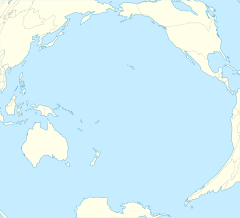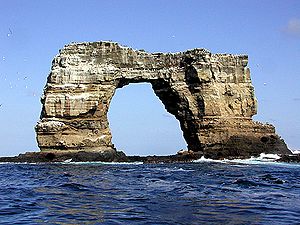Darwin Island facts for kids
|
Location in the Galápagos Islands
|
|
| Geography | |
|---|---|
| Location | Galápagos Islands, Ecuador |
| Coordinates | 1°40′41″N 92°00′11″W / 1.678°N 92.003°W |
| Archipelago | Galápagos Islands |
| Administration | |
Darwin Island (in Spanish: Isla Darwin) is one of the smallest islands in the famous Galápagos Archipelago. It covers an area of just 1 square kilometer (about 0.4 square miles). The island is named after the famous English scientist Charles Darwin.
There are no easy places to land on Darwin Island. Because of this, its main attractions are found underwater in the Pacific Ocean. The waters around Darwin Island are full of amazing marine life.
Even though the island was on maps and first called Culpepper Island, no one actually landed there until 1964. This first landing was done by helicopter. Darwin Island and nearby Wolf Island are sometimes called Darwin and Wolf. They were once known as Culpepper and Wenman.
Island's Story: How Darwin Island Formed
Darwin Island is actually what's left of an old, inactive volcano. It rises 165 meters (about 541 feet) above the sea. This island is located northwest of the main Galápagos Islands. It sits on a special underwater line called the Wolf-Darwin Lineament.
This line stretches from the Galápagos Platform to the Galápagos Spreading Centre. This spreading center is where two huge pieces of the Earth's crust, called the Nazca and Cocos tectonic plates, are moving apart.
The way Darwin Island formed is different from how the main Galápagos Islands were made. Scientists have two main ideas about how this lineament formed. One idea is that hot, melted rock (magma) from deep inside the Earth was pushed towards the spreading center. Another idea is that new magma rose up because of stress in the ocean floor.
Darwin Island is the most northern of two peaks on the Wolf-Darwin Lineament that stick out of the water. The other peak is Wolf Island, which is about 40 kilometers (25 miles) away. There are also other peaks underwater.
The volcano that created Darwin Island is no longer active. Scientists believe its last eruption happened about 400,000 years ago. This makes it younger than Wolf Island. The lava flows around Darwin Island look very similar. This is probably because the island is quite young.
Scientists think Darwin Island had at least two big eruption periods. These eruptions left behind layers of volcanic rock. Evidence also suggests that Darwin Island was once much bigger. Over a long time, the ocean and weather slowly wore away parts of it.
Darwin's Arch was a natural rock arch that was once part of this larger structure. It was located less than a kilometer from Darwin Island. This arch was a famous landmark for the few visitors to the island. Sadly, it collapsed in May 2021.
Amazing Animals: Wildlife Around Darwin Island
Darwin Island is not open for people to visit on land. This is to protect its unique environment. So, the only visitors are those who come to scuba dive in the surrounding waters. Because it's far from the main islands, only a few special diving boats visit here.
The ocean around Darwin Island is full of many different kinds of marine life. You can see huge groups of fish swimming together. From June to November, giant whale sharks come to these waters. You can also spot different types of sharks, like hammerhead, Galápagos, silky, and blacktip sharks.
Other amazing creatures found here include green turtles, manta rays, and dolphins.
The island itself is also home to many birds. These include frigatebirds, red-footed boobies, and the unique vampire finch.
See also
 In Spanish: Isla Darwin (Galápagos) para niños
In Spanish: Isla Darwin (Galápagos) para niños




